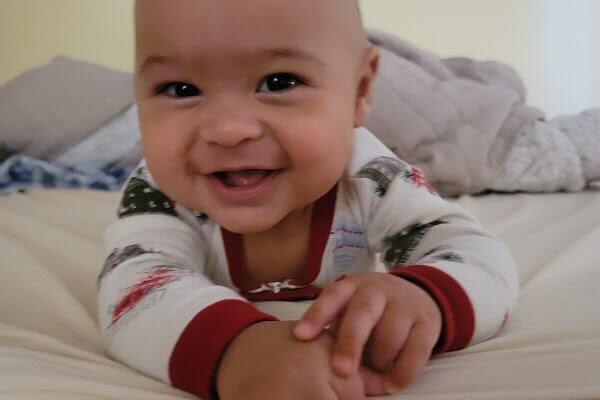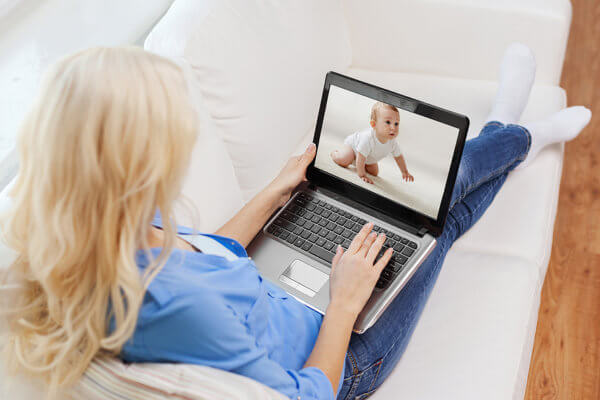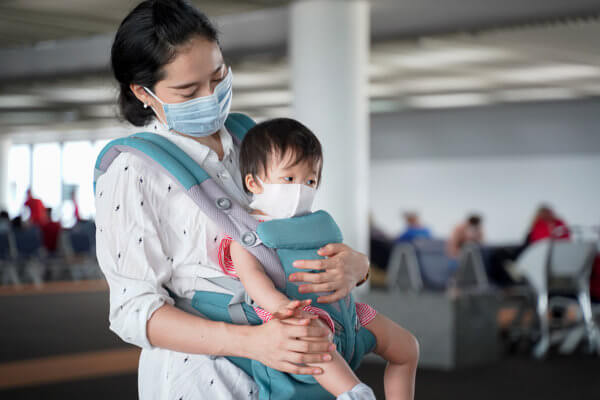By Alexa Joy Sherman
We all know the days of playing outside in the sun, unprotected, are long gone. But while we scramble to cover our kids with sunscreen and whatever else is readily available (Hats! Sunbrellas! Baby-size body armor!), research suggests we may not be doing enough. In fact, according to one Archives of Dermatology study, even when new moms were counseled about protecting their children from the sun, 22 percent of their babies burned or tanned in their first summer, and 54 percent burned in their second—effectively doubling their chances of developing melanoma later in life.
It’s not that we’re knowingly neglecting our little ones, but rather that sun can damage sensitive new skin much more quickly than we realize. “Most parents of young children are concerned and diligent about applying sunscreen—but exposure is still exposure, and every child falls through the cracks at some point,” explains Maribeth Chitkara, MD, a spokesperson for the Skin Cancer Foundation and a pediatrician at Stony Brook University Medical Center, both in New York. Here’s how to increase the odds of your pint-size beachgoer having fun in the sun while minimizing the ill effects of those ultraviolet (UV) rays.
You gotta have shade
The American Academy of Pediatrics (AAP) recommends that babies be kept out of direct sunlight altogether until they are 6 months old. That doesn’t mean you can’t venture outdoors with your infant at all, though. “When possible, plan activities so you avoid the periods of most intense ultraviolet radiation—typically between 10 a.m. and 4 p.m.,” advises Jeff Ashley, MD, president of Sun Safety for Kids and a clinical professor of dermatology at the University of Southern California’s Keck School of Medicine in Los Angeles. Ashley also suggests checking the UV Index and finding shade wherever you can—play beneath a leafy tree or protective cover at the park, and drape a blanket over the stroller canopy.
All scream for sunscreen
When your baby reaches 6 months of age, you can start putting sunscreen on him. However, you must select products carefully and be vigilant about when and how often you use them. “It’s very important to choose a product that screens UVA rays as well as UVB,” says Ashley, who suggests a sun protection factor (SPF) of 30 or higher. Be aware that companies are not yet required to specify precisely how much UVA protection their products contain, so it’s a good idea to look for a “broad spectrum” sunscreen with a high SPF—and pay attention to the new four-star UVA guide, in which a four-star rating indicates the highest protection available in an over-the-counter product, according to the AAP.
You might also opt for baby-specific products, which contain fewer chemicals, irritants and allergens—but don’t assume that your baby won’t have a reaction to them. “It’s really a matter of trial and error,” says Chitkara. Especially if your little one has a history of sensitive skin or eczema, apply a drop or two of sunscreen on a patch of his skin and wait 30 minutes before going out, Chitkara advises. If a reaction develops, try another brand.
Of course, when it comes to little faces, sunscreen can be a major source of tears—which is why Chitkara recommends thicker zinc oxide options that come in stick form and don’t run into the eyes as much. Sunscreen that runs into your little one’s eyes “can ruin your entire day at the beach,” Chitkara points out.
Another important, but often overlooked, piece of advice: Apply sunscreen a good 30 minutes before going outside and every two hours thereafter. “Most people go to the beach, unload the car, move everyone to the sand, put up the umbrella and chairs, then line up all the kids for their sunscreen,” says Chitkara. “At that point, you’ve all been exposed to the sun for 30 minutes!”
And slather it on liberally. Your child’s skin should be pretty slick after the sunscreen is applied. Don’t rub it in all the way; let it stay there and it will be absorbed after about 20 minutes.
Extra protection
One of the best ways to keep your little one’s skin safe from the sun is with SPF swim shirts and other types of apparel—an especially attractive option to parents who don’t want to rub chemicals onto their children. “No studies have shown that sunscreen is harmful, but clothing that comes with a broad spectrum—usually a universal protection factor, or UPF, of about 50—protects your child all day long, so you don’t need to apply sunscreen on any of those areas the clothing covers,” Chitkara notes. In fact, Ashley adds, clothing is often more effective and ultimately less expensive than frequent use of sunscreen. “Of course, it’s important during warm weather to choose garments that are lightweight and loose-fitting to avoid overheating,” he adds. Look for tightly woven cotton that covers the arms and legs, recommends the AAP.
Hats and sunglasses are also essential. “There are different shampoo companies that make protective sprays for the scalp, but I try to emphasize wearing a hat and sunglasses if you can get your kids to keep them on,” says Chitkara. Seek out wide-brimmed hats that shield the face, neck and ears, and lenses that block 99 to 100 percent of ultraviolet rays. Placing removable mesh window shields in your car windows—particularly during long car trips—or investing in UV window film, which can screen almost 100 percent of ultraviolet radiation without reducing visibility, are additional measures for your child’s comfort and protection.
Supplement the sunshine vitamin
Doing the sun-protection job well requires tapping alternate sources of the sun’s nourishing benefits for your little one. We all need vitamin D for strong bones, and there are three ways to get it: sun exposure, diet and vitamin supplements. However, because of the damage sun can cause, along with the fact that sunscreens may impede the absorption of the vitamin, the AAP recommends that children get 400 IU per day, starting from birth, from their diet and/or supplements. Since human milk doesn’t contain enough vitamin D to prevent rickets (a bone disease that can compromise growth and cause other health problems), nursing moms will probably be told to give multivitamin drops to their babies. Formula-fed infants, on the other hand, will get a sufficient amount of vitamin D from 27 to 32 ounces of formula per day. After the age of 1, children need just consume 32 ounces or more of vitamin D–fortified milk daily and/or take a multivitamin.
A final sun fact worth noting: While many of us assume that getting burned is a summer-specific scenario, protecting your child from damaging UV rays is a year-round responsibility. So always have a tube of SPF 30 (or more) at the ready—and shield your little ones, as well as yourself, whether or not you can see the sun.
Burn Notice
A sunburn isn’t just painful—it can lead to skin cancer later in life. “Parents should do everything in their power to make sure their child doesn’t get a sunburn, because once the damage is done, we don’t yet have a proven remedy,” says Jeff Ashley, MD, president of Sun Safety for Kids. In the event your little one does get too much sun—especially a blistering burn—take cover and consult your doctor pronto. To soothe the soreness, apply some topical aloe and (if approved by your pediatrician), over-the-counter ibuprofen or acetaminophen. “Sometimes if it’s really bad, you might need to increase your child’s fluid intake, but I would leave that up to the pediatrician to ascertain,” adds Maribeth Chitkara, MD, Skin Cancer Foundation spokesperson.
NEXT: The Best Sun Safeguards
{pagebreak}
The Best Sun Safeguards
MD Moms Babysafe Sunscreen SPF 30+Towelettes
These award-winning soft wipes are saturated with a gentle, sweat-proof, broad spectrum SPF 30+ sunscreen that’s enriched with Vitamins E and B5, marine silk, aloe and oat, to protect, soothe and moisturize even the youngest baby’s skin. Each wipe contains enough sunscreen to cover baby from head to toe, with no fuss and no mess. They’re a dermatologist-approved way to keep baby protected from UV rays at any age, anywhere, anytime. 3 packs for $60 (retail value $78. Special running through Memorial Day.)
Kel-Gar UV Sun Stop’r Kwik Cabana with Shade
With an easy “pop” mechanism for fast opening and closing, this tent is made of UPF 50-plus protective fabric that blocks 98 percent of the sun’s harmful UVA and UVB rays. Great for the beach, backyard, park and more. $50.00
Solartex Long-Sleeved Sun-Suit
The cool, soft fabric and bright colors of this SPF-50 one-piece make your child easy to spot, and are recommended by the Skin Cancer Foundation. They’re also chlorine-resistant and long-lasting, and baby sizes offer snaps at the crotch for easy diaper changes. $44.90, ages 6 months to 8 years
Sungrubbies Paint-a-Hat
It’s a wearable UPF 50-plus sun shield and art project all in one! Pediatrician-recommended, lightweight and adjustable for ages 2 to 6, the white hat comes with a choice of green, navy or orange brims, six nontoxic paint colors and four disposable brushes. $24.95
How to protect your little one from harmful rays.



